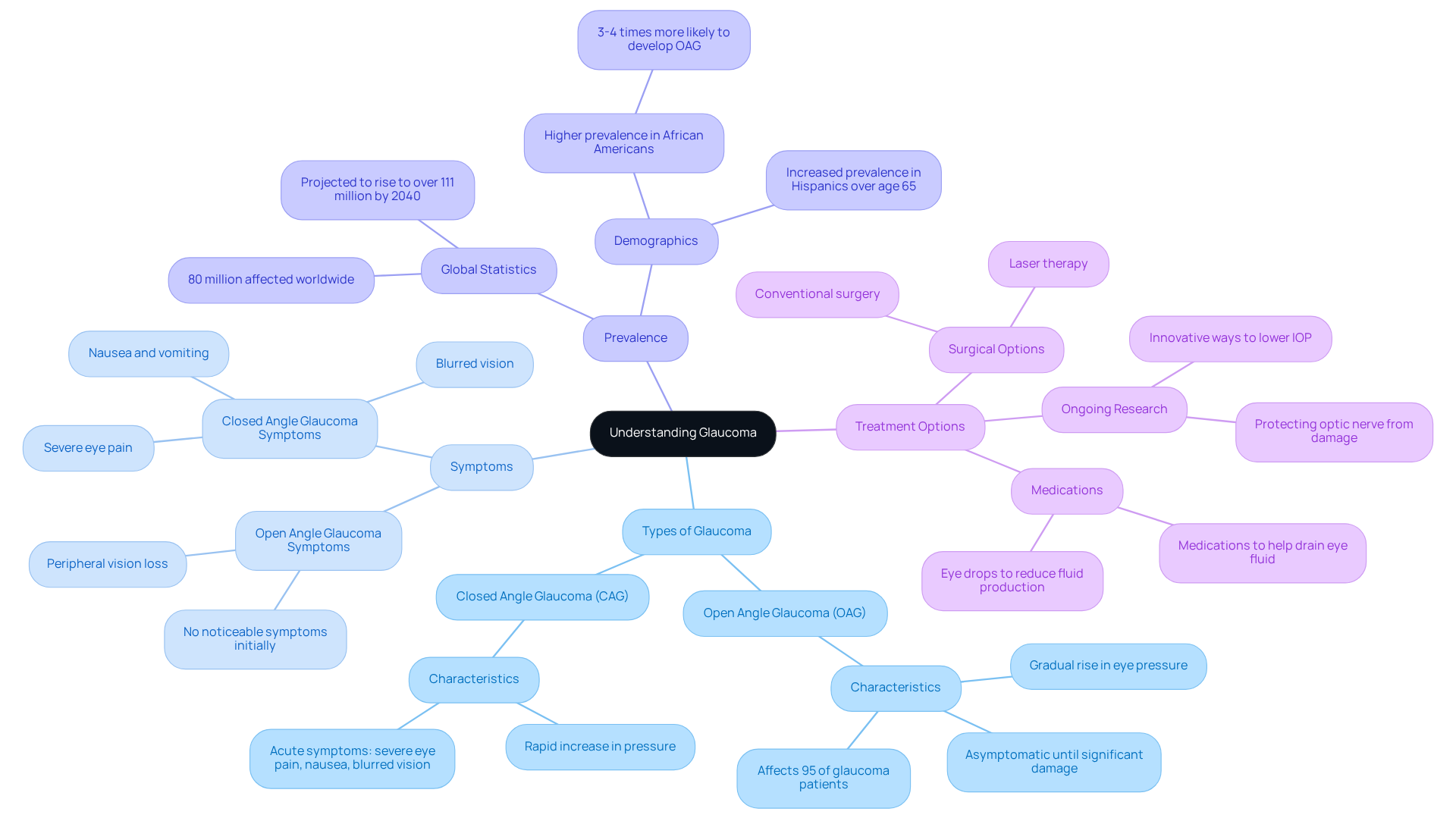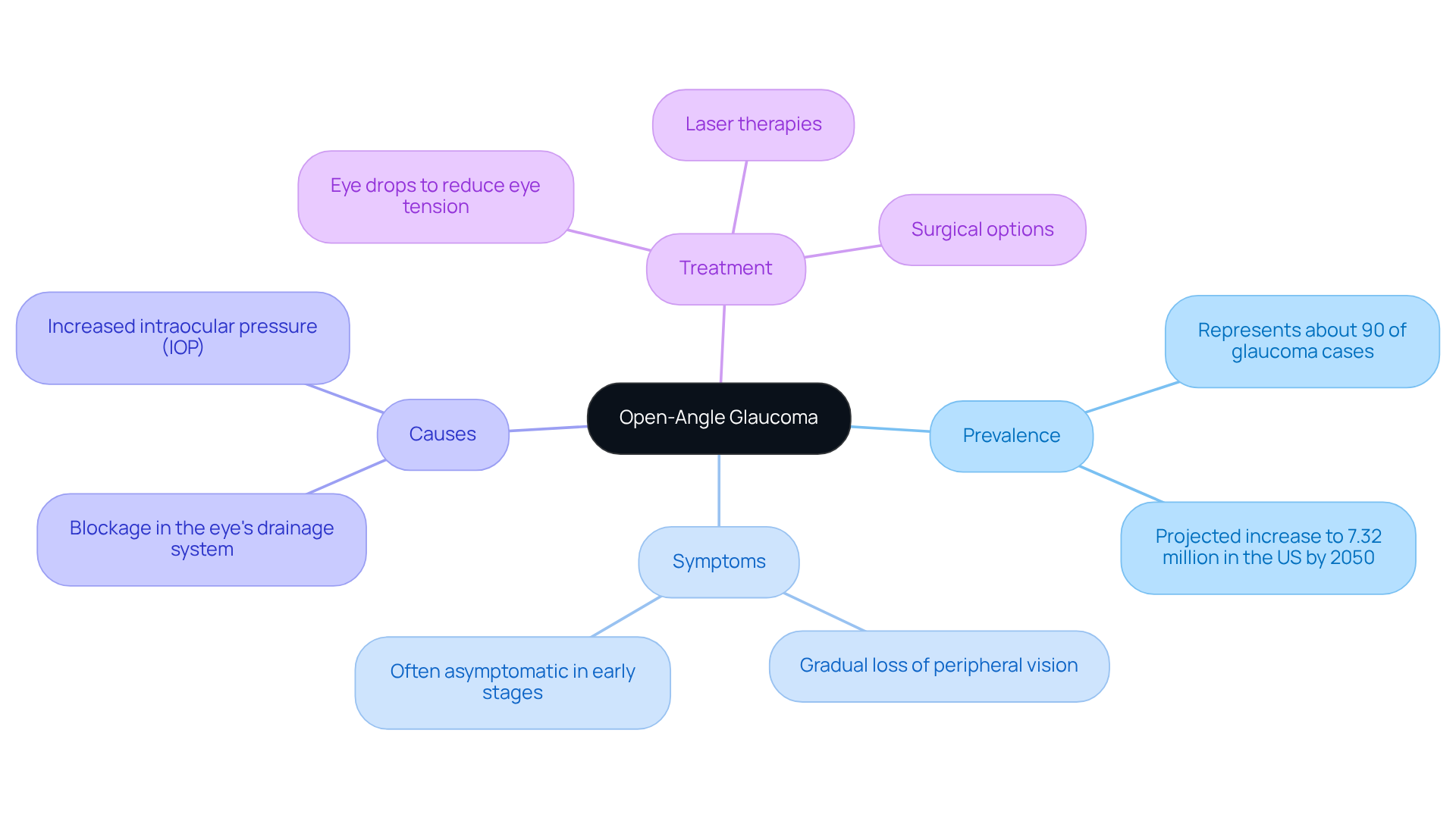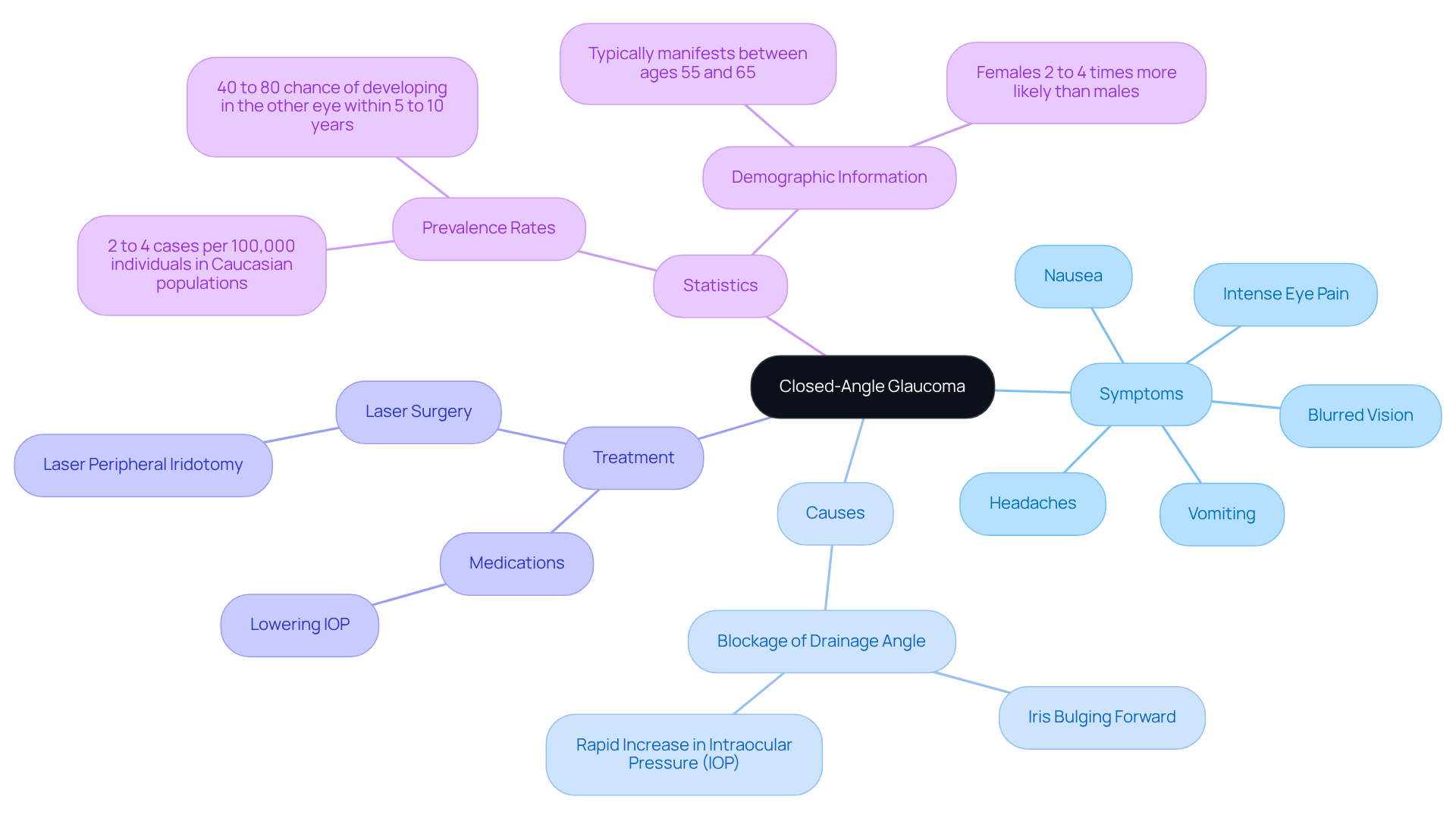Posted by: Northwest Eye in Glaucoma on November 21, 2025
Introduction
Glaucoma is a group of eye disorders that can lead to irreversible blindness, affecting millions worldwide. We understand that many people may not be aware of its different forms, which can be concerning. Among these, open angle and closed angle glaucoma present contrasting challenges. Open angle glaucoma often creeps in silently, while closed angle glaucoma can strike with alarming suddenness.
This article delves into the key differences between these two types, offering insights into their symptoms, causes, and treatment options. It’s common to feel overwhelmed when faced with such information, but understanding these distinctions can empower you to take proactive steps in safeguarding your vision. We are here to help you through this process.
Understanding Glaucoma: Overview and Types
Glaucoma encompasses various eye disorders that can harm the optic nerve, primarily due to increased intraocular pressure (IOP). It’s one of the leading causes of blindness worldwide, affecting around 80 million people. Alarmingly, this number could rise to over 111 million by 2040. Among the different types of glaucoma, open angle vs closed angle glaucoma are the most common.
OAG is characterized by a gradual rise in eye pressure, often without noticeable symptoms until significant damage has occurred. On the other hand, CAG can cause a rapid increase in pressure, leading to acute symptoms like severe eye pain, nausea, and blurred vision. Understanding the distinction of open angle vs closed angle glaucoma is crucial for timely diagnosis and intervention.
We understand that learning about these conditions can be overwhelming. Recent research highlights the importance of recognizing these eye disorders. For instance, OAG affects about 95% of those diagnosed, with African Americans being three to four times more likely to develop this condition compared to non-Hispanic whites. This asymptomatic nature has earned OAG the nickname ‘sneak thief of sight,’ underscoring the need for regular eye exams to catch the disease early.
Fortunately, effective treatment options are available for both forms of glaucoma. These include medications, typically eye drops, that help drain eye fluid more effectively or reduce fluid production. Other options are laser therapy and surgical interventions. Ongoing studies are exploring innovative ways to lower IOP and protect the optic nerve from damage, emphasizing the importance of continuous research in this area.
Real-world examples show that patients who adhere to their prescribed treatment regimens can maintain a good quality of life and prevent significant vision loss. As glaucoma remains a major cause of irreversible blindness, understanding its types and the importance of early detection is vital for preserving sight and enhancing overall health. Remember, we are here to help you through this process.

Open-Angle Glaucoma: Symptoms, Causes, and Treatment
Open-angle glaucoma is the most common type of glaucoma, representing about 90% of cases when discussing open angle vs closed angle glaucoma. We understand that learning about this can be concerning, especially since it often develops slowly and may not show symptoms in its early stages. You might notice a gradual loss of peripheral vision, which can go unnoticed until significant damage has occurred.
The primary cause is believed to be a blockage in the eye’s drainage system, leading to increased intraocular pressure (IOP). It’s common to feel anxious about this, but know that treatment options are available. Typically, prescribed eye drops can help reduce eye tension, and there are also laser therapies or surgical options if necessary.
Regular eye exams are crucial for early detection and management. We are here to help you through this process, ensuring you receive the care you need. Remember, taking proactive steps can make a significant difference in your eye health.

Closed-Angle Glaucoma: Symptoms, Causes, and Treatment
When discussing open angle vs closed angle glaucoma, it’s important to note that closed-angle glaucoma, also known as angle-closure glaucoma, is a rarer but more severe form of this eye condition. We understand that learning about this can be concerning. This condition occurs when the iris bulges forward, blocking the eye’s drainage angle and causing a rapid increase in intraocular pressure (IOP). Symptoms can appear suddenly and may include:
- Intense eye pain
- Headaches
- Nausea
- Vomiting
- Blurred vision
It’s important to recognize that this type of eye condition is classified as a medical emergency, requiring immediate attention.
Statistics indicate that if left untreated, acute angle-closure glaucoma can lead to a 40% to 80% chance of developing the condition in the other eye within 5 to 10 years. This condition typically manifests between the ages of 55 and 65, and it’s noteworthy that females are 2 to 4 times more likely to be affected than males. In Caucasian populations, the occurrence of acute angle-closure glaucoma is about 2 to 4 cases per 100,000 individuals.
Treatment usually involves medications aimed at lowering IOP, and in some cases, laser surgery may be necessary. For instance, laser peripheral iridotomy creates a new drainage pathway to help alleviate pressure. We want to emphasize that prompt intervention is crucial to prevent irreversible vision loss. Delays in treatment can lead to significant and permanent damage to the optic nerve.
Regular eye examinations are vital for early detection. We understand that untreated acute angle-closure glaucoma can progress to malignant glaucoma, illustrating the critical differences in risks between open angle vs closed angle glaucoma. Remember, we are here to help you through this process, and seeking care early can make a significant difference.

Comparative Analysis: Open-Angle vs. Closed-Angle Glaucoma
When examining the differences between open angle vs closed angle glaucoma, it’s important to acknowledge the feelings and concerns of those affected. Open-angle eye disease, impacting around 95% of individuals with this condition, typically progresses slowly and often goes unnoticed until significant sight loss occurs. We understand that this can be alarming. In contrast, closed-angle eye condition can appear suddenly, presenting acute symptoms like intense eye pain, nausea, and blurred vision. This situation requires urgent medical attention to prevent permanent vision loss, and we want you to know that help is available.
Treatment approaches vary significantly between open angle vs closed angle glaucoma. Open-angle eye disease is usually managed through long-term medication regimens aimed at reducing intraocular pressure, along with regular monitoring to track disease progression. Patients may use eye drops that help drain fluid or decrease its production. Recent advancements in treatment options, including laser therapies and less invasive surgical techniques, are being explored to improve patient outcomes. We are here to help you navigate these options and find the best path forward.
On the other hand, closed-angle eye condition demands immediate action. This often involves laser surgery to create a new drainage pathway for the aqueous humor, relieving pressure within the eye. It’s crucial to act quickly, as untreated closed-angle eye pressure can lead to rapid vision loss. We understand that facing such a situation can be overwhelming, but timely intervention can make a significant difference.
Risk factors for these conditions also differ. Open-angle ocular hypertension is primarily linked to advanced age, family history, and elevated intraocular pressure. Studies show that the prevalence increases significantly with age, ranging from 1.1% in individuals aged 40-49 to 9.2% in those over 80. The overall global prevalence of primary open-angle eye disease (POAG) is reported to be 2.4%. In contrast, closed-angle eye condition is often associated with anatomical features, such as a shallow anterior chamber, which can predispose individuals to acute episodes.
Understanding the differences in open angle vs closed angle glaucoma is essential for effective diagnosis and treatment. As one eye disease expert noted, ‘Identifying the symptoms and risk factors linked to each form of this condition can greatly influence patient outcomes.’ Recent studies continue to shed light on the complexities of eye condition treatment, emphasizing the need for personalized strategies based on individual patient profiles. Furthermore, the financial impact of managing these conditions is significant, with costs projected at $2.86 billion each year in the U.S. It’s also concerning that over 56% of glaucoma cases remain undiagnosed, highlighting the importance of awareness and early detection in managing both types of glaucoma. We are here to support you in understanding these conditions and encourage you to seek care if you have any concerns.

Conclusion
Understanding the differences between open angle and closed angle glaucoma is essential for effective management and treatment of these eye conditions. We understand that navigating these conditions can be overwhelming, but knowing the distinctions can empower you in your journey. While both types can lead to significant vision loss, they differ markedly in their symptoms, progression, and urgency of treatment.
Open angle glaucoma typically develops gradually, often without noticeable symptoms. This makes regular eye exams vital for early detection. It’s common to feel anxious about what you can’t see, but staying proactive can make all the difference. In contrast, closed angle glaucoma can present with sudden, severe symptoms that necessitate immediate medical intervention to prevent irreversible damage. Recognizing these signs early can be life-changing.
The article highlights key distinctions in the treatment approaches for these two types of glaucoma. Open angle glaucoma management often involves long-term medication and monitoring, which can feel daunting. However, knowing that you have a plan in place can provide reassurance. On the other hand, closed angle glaucoma requires prompt surgical intervention to alleviate pressure. Understanding these differences not only aids in timely diagnosis but also underscores the importance of awareness and education about the risk factors and symptoms associated with each condition.
Ultimately, raising awareness about open angle vs closed angle glaucoma is crucial for preserving vision and improving patient outcomes. We encourage you to take proactive steps today, such as scheduling regular eye examinations and educating yourself on the signs and symptoms. This can lead to earlier interventions and better management of these potentially debilitating conditions. Remember, you are not alone in this journey; we are here to help you through the process, ensuring that your eye health and quality of life remain a priority.
Frequently Asked Questions
What is glaucoma?
Glaucoma refers to a group of eye disorders that can damage the optic nerve, primarily due to increased intraocular pressure (IOP). It is one of the leading causes of blindness worldwide, affecting around 80 million people.
What are the main types of glaucoma?
The two most common types of glaucoma are open-angle glaucoma (OAG) and closed-angle glaucoma (CAG).
How does open-angle glaucoma (OAG) differ from closed-angle glaucoma (CAG)?
OAG is characterized by a gradual rise in eye pressure without noticeable symptoms until significant damage occurs. In contrast, CAG can cause a rapid increase in pressure, leading to acute symptoms such as severe eye pain, nausea, and blurred vision.
Why is it important to distinguish between open-angle and closed-angle glaucoma?
Understanding the distinction between these types of glaucoma is crucial for timely diagnosis and intervention, which can help prevent significant vision loss.
Who is more likely to develop open-angle glaucoma?
OAG affects about 95% of those diagnosed, with African Americans being three to four times more likely to develop this condition compared to non-Hispanic whites.
What are the treatment options available for glaucoma?
Effective treatment options for glaucoma include medications (typically eye drops) that help drain eye fluid or reduce fluid production, as well as laser therapy and surgical interventions.
What recent research highlights the importance of glaucoma awareness?
Recent studies emphasize the need for regular eye exams to catch glaucoma early, as OAG is often asymptomatic and has been referred to as the ‘sneak thief of sight.’
How can adherence to treatment affect patients with glaucoma?
Patients who adhere to their prescribed treatment regimens can maintain a good quality of life and prevent significant vision loss, highlighting the importance of ongoing management of the condition.
What is the future outlook for glaucoma research?
Ongoing studies are exploring innovative ways to lower intraocular pressure and protect the optic nerve from damage, emphasizing the need for continuous research in this area.






